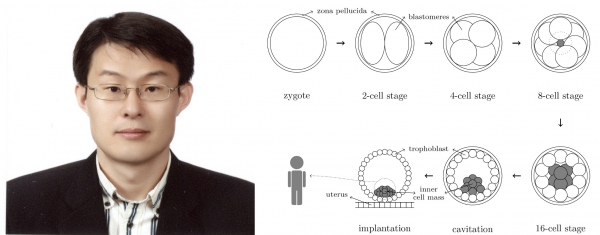
With many controversies regarding abortion and scientific experiments on zygotes, whether a zygote is a human being has become an important question. Recently Professor Chunghyoung Lee (HSS) published a paper tackling this question in The Philosophical Review, and it has been selected as one of the “10 Best Philosophy Papers of 2022”.
Prof. Lee argues against conceptionism, the view that a human being begins to exist at conception in the form of a zygote, by applying philosophical theories to results of recent biological research.
Prof. Lee starts his thesis with arguments from twinning. Conceptionism claims that every infant, child, or adult is numerically identical (e.g. Peter Parker is Spiderman) with the zygote she came from. But in the case of identical or monozygotic twins, this claim is proven false because while identical twins Betty and Chloe come from the same zygote z, they are numerically distinct from each other, and thus they cannot both be identical with the zygote z.
This twinning argument, however, has a limitation. Even if identical twins are numerically distinct from the zygote they come from, it does not mean that a singleton, an infant or adult born singly rather than one of a multiple birth, must also be numerically distinct from the zygote she comes from. Conceptionists might insist that unlike twins, who may begin to exist after division, singletons begin their life at fertilization.
Prof. Lee presents a novel argument that even a singleton is numerically distinct from the zygote she comes from. He first shows that a human zygote is developmentally plastic, that is, a zygote that naturally develops into a singleton could have naturally developed into a numerically distinct singleton. The cells of an early human embryo differentiate into two distinct types, the inner cell mass (ICM) and trophoblast. Only the ICM eventually develops into the infant, so the infant is determined by what cells form the inner mass, not by the zygote itself. If the cells that form the trophoblast had formed the ICM, an infant numerically different from the actual infant would have developed. Thus, an infant is numerically distinct from the zygote it comes from.
Then, when does a human being begin to exist? The ICM is again differentiated to two layers of cells, primitive endoderm and epiblast, and it is the epiblast that forms the body of the infant. So human can be viewed to begin to exist only after this layers are formed, which is approximately 8 days after fertilization.
In conclusion, a zygote is not identical with the human it develops into; “developing into human” does not mean it is a human being. This is analogous to why we do not take an ovum and sperm to be a zygote even though they may merge and develops into one. This result is anticipated to solve many debates surrounding viewing embryos as a human being.


